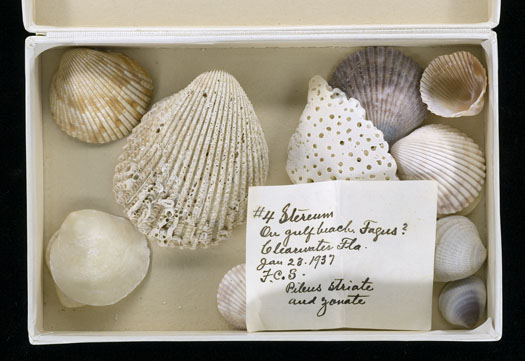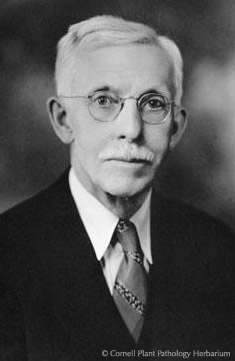Something funny in the herbarium
There are thousands upon thousands of interesting specimens contained in the Cornell Plant Pathology Herbarium. Every now and then, an extraordinary specimen is uncovered — an apocryphal specimen, if you will.

I was adding data for Aleurodiscus specimens to our database and decided to add the few remaining specimens in the same drawer. When I came to CUP 25787, I found a wonderful surprise. The label seemed ordinary enough; I expected to find a typical Stereum specimen in the box.
Instead, I found the unexpected (below). This is, of course, a joke. Stereum is a genus of bracket fungi with a smooth undersurface lacking gills or pores. The epithet “seashellia” gives away the actual identity of the specimens in the box. And Fagus is the genus name of beech trees (beech. beach. get it?).

For the specimen to have been accessioned into the Herbarium, Dr. Stewart must have had the cooperation of H.H. Whetzel or H.M. Fitzpatrick. In Stewart’s obituary we learn: “He had a pleasant disposition, a well developed sense of humor, and thoroughly enjoyed a good joke, especially when it dealt with human interest or reaction.”
Fred Carleton Stewart was a native of French Creek, New York, who got his BS (1892) and MS (1894) degrees from Iowa State University.1 He was Assistant Botanist of the Iowa Agricultural Experiment Station from 1891 to 1894 where he worked with Professor L. H. Pammel, Botanist of the Station. Stewart’s training with Prof. Pammel strengthened his interest in plant diseases.
 Stewart next took the position of Mycologist at the new Long Island Branch Station at Jamaica, New York (Dec. 1894-1897). His main accomplishments there were his field experiments in controlling diseases of potato and market-garden crops, and his demonstration of the bacterial nature of a newly discovered wilt disease of sweet corn. Back then, bacteria weren’t believed to be major causes of plant diseases, and Plant Pathology was a brash new discipline that arose from Applied Mycology. In 1898, Erwin F. Smith dubbed the disease “Stewart’s disease of sweet corn,” and named the causal organism Pseudomonas stewartii. Nowadays, we call the disease “Stewart’s wilt” and the bacterium has recently been renamed Pantoea stewartii to better reflect its affinities. We now know it is transmitted mainly by the diminutive but voracious corn flea beetle.2
Stewart next took the position of Mycologist at the new Long Island Branch Station at Jamaica, New York (Dec. 1894-1897). His main accomplishments there were his field experiments in controlling diseases of potato and market-garden crops, and his demonstration of the bacterial nature of a newly discovered wilt disease of sweet corn. Back then, bacteria weren’t believed to be major causes of plant diseases, and Plant Pathology was a brash new discipline that arose from Applied Mycology. In 1898, Erwin F. Smith dubbed the disease “Stewart’s disease of sweet corn,” and named the causal organism Pseudomonas stewartii. Nowadays, we call the disease “Stewart’s wilt” and the bacterium has recently been renamed Pantoea stewartii to better reflect its affinities. We now know it is transmitted mainly by the diminutive but voracious corn flea beetle.2
After a year off for additional training in plant pathology at Cornell and in Europe, in 1898 Stewart became Botanist and the Head of the Department of Botany of the New York Agricultural Experiment Station at Geneva. In 1923, the Station became part of Cornell University, and Stewart became a Professor of Botany at Cornell. Despite his duties as a plant pathologist, he also managed to publish a handful of papers on edible wild mushrooms and mushroom cultivation.e.g., 3 When he finally retired in 1936 he was granted the distinguished title of Professor Emeritus. Just a year later he sent us a message from retirement–a lovely box of seashells.
We are currently pursuing a rumor that a mustache removed from a Victorian-era mycologist is somewhere in the herbarium. We’re sure Stewart would appreciate the humor in this, even if it turns out to be a scurrilous rumor. We’ll keep you posted.
- Fitzpatrick, Harry M. 1947. Fred Carleton Stewart: 1868-1946. Phytopathology 37: 687-697.
- Pataky, Jerald K. 2003. Stewart’s Wilt of Corn. APSnet Feature Story, July-Aug 2003. American Phytopathological Society.
- Stewart, F.C. 1936. The uncertain Hypholoma. NY State Ag. Experiment Stn. Bulletin 666. [on the edibility of the mushroom now known as Psathyrella incerta]
- Stereum seashellia portraits by Kent Loeffler
- Photo of F.C. Stewart from the Cornell Plant Pathology Herbarium Photo Archives. CUP 31762a.


[…] we were introduced to the Cornell Herbarium and the surprising things sometimes found in such institutional collections of dried specimens. When I was a grad student, I […]
That’s a touching story, and it did give me a bit of a chuckle. It’s always interesting to find humorous hidden easter egg type things like this that our predecessors have left behind.
[…] (the first of their species to be named; bearers of the names of their species), the occasional seashell, and a lot of other things we love or have barely even […]